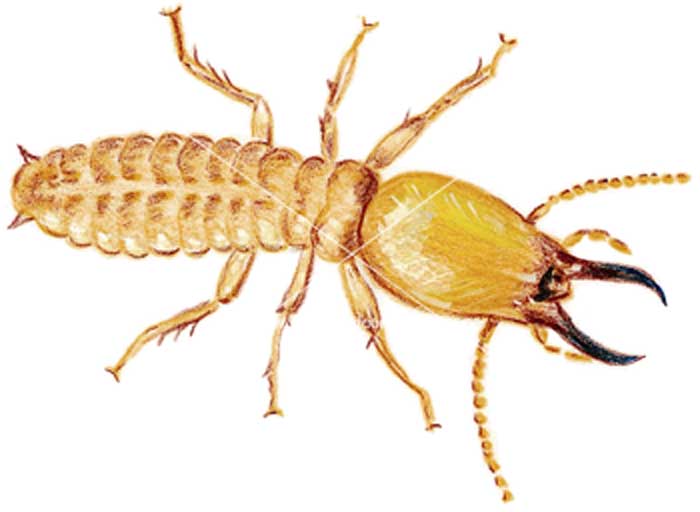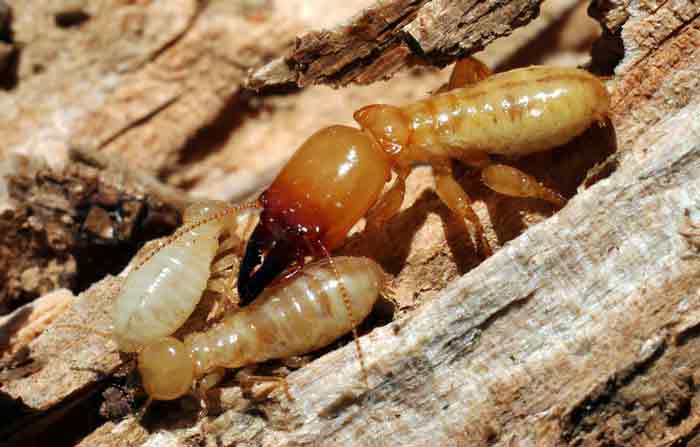Seen a dampwood termite in your home? Find out what it is in terms of its appearance with pictures, how you can identify it. It further explains the damages this type of termites are likely to cause to your home and tips on how you can get rid and prevent an infestation.
Table of Contents
What they’re + Scientific name
They are scientifically called Zootermopsis spp. or Neotermes spp. They are also loosely called rotten wood termites. They are associated with high content of moisture as the wood decays. They are majorly found in the fallen trees and the forests near your home.
The nymphs of these termites are the ones to take care of the kings and queens of the colonies. The notable issue about these termites is that they create series of chambers in the damp wood. The chambers are connected by the tunnels having smooth walls that are similar to a surface that has been sandpapered.
Identification
These termites are larger than the subterranean termites. They can be as long as 1 inch with the inclusion of their wings. The soldier termites contain large red brown heads and large mandibles with multiple teeth. You can also identify them because they establish their nests almost throughout the year from January to October.
Pictures
The pictures below give you clear view of the appearance of the termites and help you to easily identify them when they attack.
Infestation Signs
- The signs of infestation by these termites is quite different from the others. This is because they do not form tunnel tubes through the wood. They are just attracted to the wood because of the moisture
- You will also see wings around the damp wood structures or the lamps or woods or trees that contain adequate moisture.
- The termites sometimes use their Frass to seal their living areas from the external air and potential death from predators.
- They are both males and females both winged for purposes of mating and creating new colonies. They thus may be easily confused with other ants. What makes them different is the presence of straight antennae, straight sided body and four pairs of wings that are equal in length.
Damage
They do not entirely infest structures because of their specific requirement, moisture. However, they can cause a lot of damage if care is not taken.
If you allow your furniture to be soaked in moisture, then the chances of terrorism from the pest is almost always given. They, together with other pests account for about $ 5 billion equated to damage every year.
These termites can lead to the weakening of the frames of doors and windows of your house which in turn can lead to expensive repairs.
They carry out their activity silently and this makes it hard for recognition until appreciable damage is done. The wood that is full of moisture and the termites ends up contracting fungus. This leads to the full destruction of the wood.
How to get rid & Treatment
The methods used to deal with these termites is almost similar to the other methods used to deal with other termites.
When a material or a piece of wood is in contact with ground, the best and single most important remedy is to remove the wooden material from the ground or eliminate moisture from the vicinity.
Use permethrin dust
This is a chemical that brings about an immediate results. It is one of the natural insecticides that remains in force for a very long period of time. It is not only effective in killing termites but also other ants like the ticks, fleas, wasps and beetles. It is a favorite chemical among many professionals.
The use of arsenic dust
You can use it as a wash off for the termites. Once one termite in the colony gets into contact with the dust, the others in the colony will be exposed and then die. The dust is transmitted from the dead termite to the others in the colony. For this reason, they are known to be cannibalistic in nature.
Use other insecticides and foams
The foams and insecticides are the commonest methods employed in controlling termites. The only concern with this method, you have to vacate your house for some time and then spray before returning to the house.
There are various forms that the insecticides are formulated. They include gasses and liquids which you can then apply. The foams are useful because the poison from the insecticide easily accesses the cracks on the walls and thus killing the pests. Both the insecticide and the foams are useful and effective in termite eradication.
The use of baits
The use of baits that contain boric acid have been in use and prove to be very effective. They immediately and within a short time terminate the population of the termites.
All you should do is set up a station that has the bait with boric acid. Once you have set the bait, spray the boric acid all over. The termites are attracted to the bait and boric acid kills them instantly.
The application of the acid to the bait should be as regular as possible as required and this quickens the process of eradication of termites.
The use of nematodes
This is a very recent development in dealing with termites. It is a biological method where the population of the termites is reduced by raring nematodes which feed on the termites. Nematodes are small worms that act as natural parasites to the pests.
They have the ability to look for the termites and then dig deep into them. They majorly target the larva stage of the termites. This is an early target and it controls the population before maturity.
The impact of this is that you will be able to mitigate any foreseen damage from the termites. The nematodes are effective because they act for a very long period of time. This is nematodes also breed and then multiply very fast.
Prevention Measures
You can also be able to prevent the termites from infesting the home. This will help reduce the likely costs that come with the treatment.
- Remove all the potential attractants of termites. You should keep all the potential attractants like mulch, stamps of trees and the rotten wood. You should also put efforts to make sure moisture is limited as far as possible. Always remove the stamps of wood from the ground and other logs of wood near the foundation of your house.
- When you remove all the potential attractants of the termites, they will relocate to look for other areas that are conducive. This reduce the risk of damages that are likely.
- Replace all the materials that have been affected by the dampwood termites. It is preferable that you use treated wood to do the replacement.
- Eliminate moisture. Ensure the roof of your house is in place and does not allow water from the rain to drip into your house. Also, ensure that you rectify all the leaking pipes and gutters under the ground and around your house.
Dampwood vs Drywood termites
- Differences
| Dampwood termite | Drywood termite |
| The dampwood reproductive termites vary in size starting from a half an inch to 5/8 of an inch in length. The soldier termites are longer measuring about ¾ of an inch. The kings and queens are different in color being darker than the soldier termites. The soldiers have pale and creamer bodies but with dark brown heads.
| They are smaller in size. Their soldier termites have a pale cream color and have brown jaws. Their heads grow to 3/8 of an inch while the reproductive termites grow to become ½ an inch in length then become light to dark. |
| They leave the fecal matter or the Frass piled up around the areas where they are active. | They leave their fecal matter in the areas where they live. The fecal matter also gets stuck in the crucks of the buildings they squeeze through into the house. |
| They have the ability and capability to live without water and they reproduce as they digest the cellulose from wood. | They do not have the ability to break down cellulose adequately. That is why they have to live near water source to help digest cellulose.[1] |
- Similarities
Despite their great differences, they also have some points of similarity in the sense that both of them have a pale colored cylindrical body and a darker head. The jaws in both are somehow large. They both feed on wood and any material that has cellulose in it. They thus cause a lot of destruction to your property.
These two types form and live in swarming colonies. Both dampwood and drywood termites form the swarming colonies. These colonies indicate the commencement of the reproductive cycle of the termites. The swarming also points out that there are chances of more colonies being formed.
Further Reading
- What Causes & Attracts Termites?
- Do Termites Bite Humans? Pictures & Remedies
- Flying Ants vs Termites-Differences & Similarities
- Termite Inspection Cost, Procedure, how long it takes & Training
- Termite Colony-Queen, Soldier, Worker & King
- Drywood Termites Treatment Cost, Get rid & Damage
- Termite Bond Cost, Benefits
- Termite Baits, Stations & DIY Traps
- Dampwood termites Pictures, Damage & Treatment
- Termite Tenting & Fumigation- Cost, Preparation, Safety & Cleaning After
- Termite Barriers (Shields): Types, Cost, how they Work & Products
- Termites Damage, Pictures, Repair Cost, Ceiling, Floors, Wood & Fix
- Best Termite Sprays-Orange Oil (DIY), Boric Acid & Spectracide Reviews
- Termites Life Cycle & Span-Eggs, Larvae, Baby & Adults
- How to Prevent Termites-Tips to Protect your Home
- Signs of Termites Infestation-How do you know if have you them?
- What do Termites look like? Pictures, Size, Color & Look-alikes
- Termites: Where From, Habitat, Eat, Noise, Types +more!
- Subterranean Termites Swarmers Treatment Cost, Damages & Pictures
- Flying Termites with Wings (Swarmers) Pictures & How to get Rid
- Termite Droppings-Drywood, what they look like, Health Risks, Clean vs Sawdust
- Formosan Termites Pictures, Signs Treatment & Damage
- How to Get Rid, Kill Termites + Treatment Cost
Sources
[1] http://www.lokavisual.com/drywood-vs-dampwood-termites-difference/

